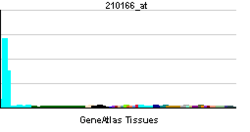TLR5
Toll-like receptor 5, also known as TLR5, is a protein which in humans is encoded by the TLR5 gene.[1] It is a member of the toll-like receptor (TLR) family.
Function
The TLR family plays a fundamental role in pathogen recognition and activation of innate immunity. TLRs are highly conserved from Drosophila to humans and share structural and functional similarities. They recognize pathogen-associated molecular patterns (PAMPs) that are expressed on infectious agents, and mediate the production of cytokines necessary for the development of effective immunity. The various TLRs exhibit different patterns of expression. TLR5 is expressed on both immune and non-immune cells.[2] TLR5 recognizes bacterial flagellin, a principal component of bacterial flagella and a virulence factor. The activation of this receptor mobilizes the nuclear factor NF-κB and stimulates tumor necrosis factor-alpha production.[3]
TLR5 recognizes flagellin,[4] which is the protein monomer that makes up the filament of bacterial flagella, found on nearly all motile bacteria. There are highly conserved regions in the flagellin protein among all bacteria, facilitating the recognition of flagellin by a germ-line encoded receptor such as TLR5.[5]
References
- ↑ Rock FL, Hardiman G, Timans JC, Kastelein RA, Bazan JF (January 1998). "A family of human receptors structurally related to Drosophila Toll". Proceedings of the National Academy of Sciences of the United States of America 95 (2): 588–593. doi:10.1073/pnas.95.2.588. PMC 18464. PMID 9435236.
- ↑ Sharma, N et al. (2013). "Sphingosine-1-phosphate suppresses TLR-induced CXCL8 secretion from human T cells.". J Leukoc Biol 93 (4): 521–528. doi:10.1189/jlb.0712328. PMID 23345392.
- ↑ "Entrez Gene: TLR5 toll-like receptor 5".
- ↑ Hayashi F, Smith KD, Ozinsky A, Hawn TR, Yi EC, Goodlett DR, Eng JK, Akira S, Underhill DM, Aderem A (April 2001). "The innate immune response to bacterial flagellin is mediated by Toll-like receptor 5". Nature 410 (6832): 1099–1103. doi:10.1038/35074106. PMID 11323673.
- ↑ Smith KD, Andersen-Nissen E, Hayashi F, Strobe K, Bergman MA, Barrett SL, Cookson BT, Aderem A (December 2003). "Toll-like receptor 5 recognizes a conserved site on flagellin required for protofilament formation and bacterial motility". Nature Immunology 4 (12): 1247–53. doi:10.1038/ni1011. PMID 14625549.
Further reading
- Hayashi F et al. (2001). "The innate immune response to bacterial flagellin is mediated by Toll-like receptor 5". Nature 410 (6832): 1099–1103. doi:10.1038/35074106. PMID 11323673.
- Lien E, Ingalls RR (2002). "Toll-like receptors". Crit. Care Med. 30 (1 Suppl): S1–11. doi:10.1097/00003246-200201001-00001. PMID 11782555.
External links
- Toll-Like Receptor 5 at the US National Library of Medicine Medical Subject Headings (MeSH)
| ||||||||||||||||||||||||||||||||||||||||||||||||
